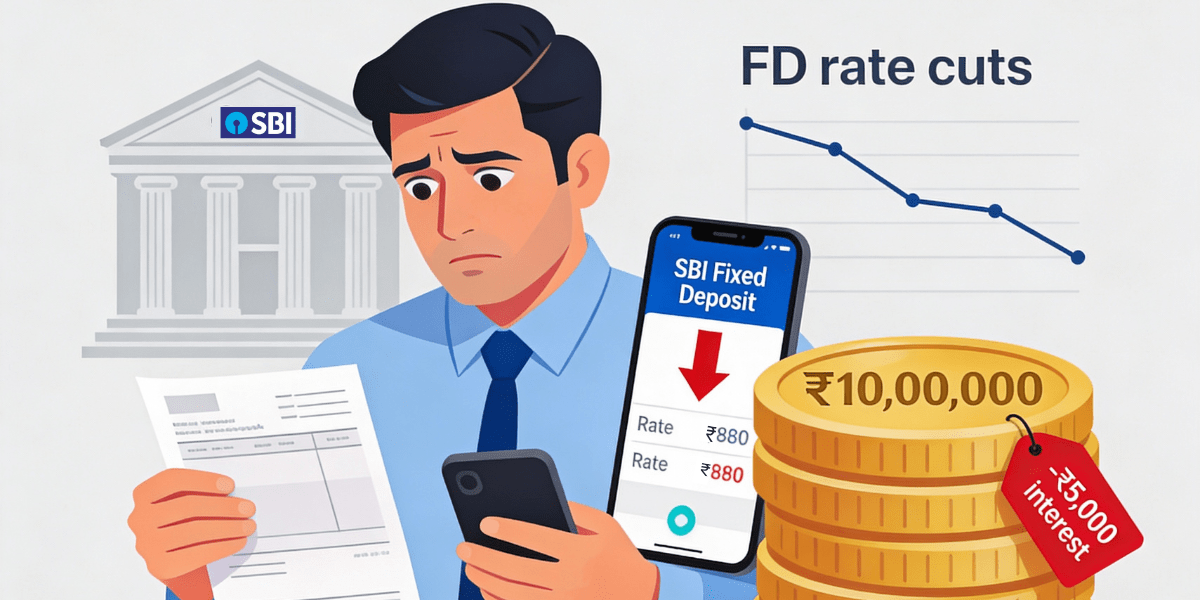
Yes Bank joins ICICI & HDFC in slashing savings rates to boost profitability. Will this strategy work? We analyze the impact on NIMs, deposit growth & customer retention compared to industry leaders. Find out how this move affects your savings & Yes Bank’s competitive position. Read our expert breakdown now!
In a strategic move to align with industry trends and enhance financial performance, Yes Bank has announced a reduction in its savings account interest rates, effective April 21, 2025. This decision follows similar actions by other major Indian banks, reflecting a broader shift in the banking sector to optimize profitability amid evolving economic conditions. With CEO Prashant Kumar at the helm, Yes Bank aims to streamline operations and bolster its bottom line, as evidenced by its robust Q4 FY25 earnings, which reported a 63% year-on-year (YoY) surge in net profit. This blog post delves into the reasons behind Yes Bank’s rate cut, its implications for customers and the banking industry, and how it positions the bank for sustainable growth.
Why Yes Bank Cut Savings Account Interest Rates
Yes Bank’s decision to lower savings account interest rates is a calculated step to improve its net interest margins (NIMs) and overall profitability. According to posts on X, the bank has revised its rates as follows: 3% for balances up to ₹10 lakh, 3.5% for ₹10-25 lakh, 4% for ₹25-50 lakh, and 5% for balances above ₹50 lakh, down from a previous high of 7% for deposits over ₹50 lakh. This adjustment, announced by CEO Prashant Kumar during a press call following the Q4 FY25 earnings, mirrors actions taken by industry leaders like State Bank of India (SBI) and HDFC Bank, which have also trimmed savings rates to navigate rising funding costs and regulatory pressures.
The primary driver behind this move is the need to enhance bank profitability. Savings accounts, while a stable source of low-cost funds, generate interest expenses that can erode margins, especially in a high-interest-rate environment. By reducing rates, Yes Bank aims to lower its cost of funds, thereby increasing the spread between the interest it earns on loans and the interest it pays on deposits. This is particularly crucial as the bank reported a net interest margin (NIM) of 2.4% in Q3 FY25, which remained flat year-on-year, indicating room for improvement.
Additionally, the Reserve Bank of India’s (RBI) monetary policy stance and liquidity conditions play a role. With expectations of a potential 25 basis points (bps) rate cut in 2025, banks are preemptively adjusting their deposit rates to maintain profitability. Yes Bank’s strategic reorientation, particularly in its retail segment, also underscores the need to optimize costs, as highlighted by its challenges with high operating expenses and low-yield retail loans.
Yes Bank’s Financial Performance: A Strong Foundation
Yes Bank’s Q4 FY25 earnings provide context for its rate cut decision, showcasing a strong financial foundation that supports its strategic shift. The bank reported a standalone net profit of ₹612.27 crore in Q3 FY25, a 164.52% YoY increase from ₹231.46 crore in Q3 FY24. For the nine months ending December 2024, net profit climbed 108.67% to ₹1,667.74 crore, driven by a 15.67% rise in total income to ₹27,396.38 crore.
Key financial highlights include:
- Net Interest Income (NII): Grew 10.2% YoY to ₹2,224 crore in Q3 FY25, though NIMs remained stable at 2.4%.
- Operating Profit: Increased 24.87% YoY to ₹1,079.02 crore, reflecting improved operational efficiency.
- Asset Quality: Gross non-performing assets (GNPA) improved to 1.6% from 2% YoY, with net NPAs at 0.5% compared to 0.9% a year ago.
- Loan Book Growth: Net advances rose 12.6% YoY to ₹2.44 lakh crore, with SME and mid-corporate segments showing 25%+ YoY growth.
These metrics indicate that Yes Bank is on a path of recovery and growth, rebounding from its 2020 crisis when it faced a moratorium due to corporate loan defaults. The bank’s focus on granular fee income, asset quality improvement, and a 32.3% YoY increase in current account savings account (CASA) deposits to ₹1.13 lakh crore further strengthens its position. However, challenges in the retail segment, including high operating costs and low-yield loans, have prompted cost-cutting measures like the savings rate reduction.
Implications for Customers
For Yes Bank customers, the savings rate cut means lower returns on their deposits, particularly for those with higher balances. Previously, the bank offered up to 7% on deposits above ₹50 lakh, making it attractive for high-net-worth individuals. The new structure, with a maximum of 5% for balances above ₹50 lakh, may prompt customers to explore alternative investment options like fixed deposits (FDs), mutual funds, or other banks offering competitive rates.
Yes Bank’s FD rates, effective April 1, 2025, range from 3.25% to 8% for the general public and 3.75% to 8.5% for senior citizens for tenures of 7 days to 10 years. These rates remain competitive, especially for senior citizens, who benefit from an additional 0.5% interest. Customers seeking tax-saving options can opt for Yes Bank’s Tax Saver FD, which offers deductions up to ₹1.5 lakh under Section 80C with a five-year lock-in.
However, the rate cut could impact customer retention, as depositors may shift to banks or financial institutions offering higher savings rates. To mitigate this, Yes Bank is likely to enhance its digital banking services and fee-based offerings to maintain customer loyalty, aligning with its focus on transactional fee streams.
Industry Trends: Why Banks Are Cutting Savings Rates
Yes Bank’s move is part of a broader trend in the Indian banking sector, where banks are recalibrating their strategies to boost profitability. Major players like SBI, HDFC Bank, and ICICI Bank have also reduced savings rates in recent years to manage funding costs. For instance, SBI slashed its savings rate to 3.5% for balances up to ₹1 crore in 2017, setting a precedent for private banks like Yes Bank.
Several factors are driving this trend:
- Rising Funding Costs: Banks are grappling with higher deposit costs as customers demand better returns amid inflation. Lowering savings rates helps reduce these expenses.
- RBI’s Regulatory Framework: SEBI’s mandate to upstream client funds to clearing corporations has increased operational complexities, prompting banks to optimize costs elsewhere.
- Shift to Fee-Based Income: Banks are increasingly relying on non-interest income, such as transaction fees and wealth management services, to offset margin pressures.
- Retail Segment Challenges: As seen with Yes Bank, retail banking strategies have faced hurdles, with high operating costs and low-yield loans necessitating cost-cutting measures.
This trend is not unique to India. Globally, banks like HSBC and Australia’s “Big Four” have cut rates to align with central bank policies and improve profitability, as seen in reports from Reuters and Morningstar.
How Yes Bank’s Strategy Positions It for 2025
Yes Bank’s savings rate cut is a piece of a larger puzzle aimed at achieving sustainable growth in 2025. CEO Prashant Kumar emphasized that Q3 FY25 marked the fifth consecutive quarter of sequential profitability expansion, with return on assets (RoA) improving to 0.6% from 0.5%. The bank’s focus on reducing provisions (down 53.36% YoY to ₹258.68 crore in Q3 FY25) and improving asset quality positions it to weather economic uncertainties.
Moreover, Yes Bank is addressing its retail segment’s inefficiencies. The bank sacked 500 junior staff in June 2024 and four senior retail executives in 2025, signaling a shift to a branch-centric model to reduce reliance on low-yield loans sourced by Direct Sales Agents (DSAs). This restructuring, while controversial, aims to lower operating costs and align with the bank’s profitability goals.
Looking ahead, Yes Bank’s ability to maintain its CASA growth, expand fee-based income, and leverage digital banking will be critical. The bank’s board is also preparing for a leadership transition, as Kumar’s term ends in October 2025. The selection of an external candidate or the corporate banking head as the next CEO could further steer Yes Bank toward a corporate-focused strategy, reducing retail-related risks.
Yes Bank’s Proactive Measures
Yes Bank’s decision to cut savings account interest rates effective April 21, 2025, reflects a strategic alignment with industry leaders to boost profitability. By reducing its cost of funds, the bank aims to improve its net interest margins and sustain its impressive financial recovery, as evidenced by a 63% YoY net profit growth in Q4 FY25. While this move may challenge customer retention, Yes Bank’s focus on asset quality, CASA growth, and digital innovation positions it for long-term success. As the Indian banking sector navigates economic shifts, Yes Bank’s proactive measures underscore its commitment to financial resilience and growth.
-

Loan Restructuring vs OTS: When to Choose Loan Restructuring or One Time Settlement
-

Axis Bank Burgundy Debit Card Stands Out as a Premium Debit Card Option
-

Shocking SBI FD Cut: Is Your ₹10 Lakh Savings Now Losing ₹5,000 Yearly?
-

The Silent Score Killer: Why Your Favourite Salary and Microloan App Could Block Your ₹50 Lakh Dream Loan



























